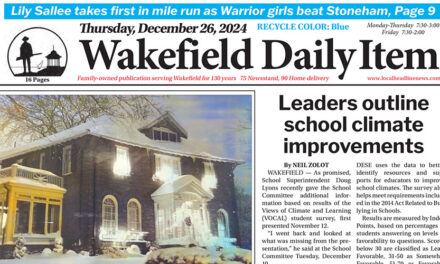Published in the September 24, 2019 edition.
By MARK SARDELLA
WAKEFIELD — Zoning Board of Appeals chairman David Hatfield took the opportunity last night to respond to concerns that have arisen in some quarters regarding the number and size of multi-family housing developments being constructed in town and resulting impacts on issues like traffic.
Members of the Zoning Board of Appeals appeared before the Town Council to update councilors on current projects and to discuss in general terms the work that the ZBA does.
Joining Hatfield for the presentation was ZBA clerk Ami Wall. Other members of the ZBA were also on hand, including Michael Feeley, Joseph Pride, Jim McBain and Greg McIntosh.
Hatfield noted that the Zoning Board has deliberated or is currently deliberating on 77 petitions for proposed projects in the past year. Those petitions have included applications for variances, Special Permits, findings and/or determinations.
He touched briefly upon some recent ZBA decisions, including the approval of the conversion of Harvard Mills office space into 183 residential units and the conversion of office space at 27-37 Water St. into a mixed-use development including 46 residential units.
Hatfield noted that the ZBA also handles applications for wireless communication facility upgrades as well as findings, Special Permits and variances for residential projects like accessory apartments, pools, renovations/additions, etc.
He also said that the board deals with commercial applicants requesting relief for signage.
Hatfield talked about some of the projects that the ZBA is currently considering, including a 173-unit 40B project on Tarrant Lane; “Greenwood Station,” a 24-unit 40B project at 998-1000 Main St.; a 26-unit project on Nahant St; 16 units proposed for 267 Water St; a proposed research/testing lab and offices at 200-400 Quannapowitt Parkway; a 12-unit project at 301 North Ave.; and several proposed improvements or changes to gas stations. He also cited several residential variances that are in the pipeline.
Hatfield addressed concerns related to overdevelopment and a perceived proliferation of multi-family/mixed-use projects. He pointed out that in November 2015, Town Meeting approved zoning changes encouraging multi-family/mixed-use developments in certain areas of town, primarily in or near business districts and along public transit lines.
Most (if not all) of these recent projects are consistent with the vision of Wakefield’s 2015-2020 Housing Plan, Hatfield said, which defines and promotes Smart Growth Development in different areas of town.
Most of the recently permitted projects are revitalizing abandoned or underutilized properties, Hatfield noted, citing 175 North Ave., a condo complex that has a restaurant (Tonno) on the ground floor, as one example. These projects result in new tenants, new customers for local businesses and a new tax base, Hatfield said, but also more traffic.
He said that the ZBA shares concerns about the collective traffic impact of projects on the West Side, in particular along Foundry Street, where several new residential projects have been approved or are in the pipeline. He noted that the ZBA issued a letter to town officials in September 2018 outlining their concerns and recommendations.
Hatfield talked about the ZBA’s typical procedure for multi-unit development proposals. Most require multiple meetings to cover all aspects of the project including, architecture, design, civil engineering, traffic, parking, landscaping, lighting, signage, Operation & Maintenance Plan and construction schedule.
The applications before the board are sent to town municipal departments requesting comments. Public testimony is heard at every meeting for every project. A ZBA subcommittee often works with the applicant team off-line on details of designs and/or architecture.
The applicant then brings updated plans back to full ZBA in a public hearing. The end result, Hatfield said, are projects that are a better fit for the neighborhoods (scale, design, style) than those originally proposed by the applicants.
After ZBA approval, the board’s work is still not done, Hatfield noted. A board member reviews “Building Set” of approved plans – a very time-consuming task, especially for large projects. Any discrepancies are corrected prior to a Building Permit being issued and construction starting.
Board members perform on-site inspections, preview a “mock-up panel” using approved materials prior to exterior construction and perform a final site walk-through when project is nearing completion. The sometimes find deficiencies that may require coming back to ZBA to request minor modifications.
Town Councilor Jonathan Chines asked about the possibility of having ZBA meetings televised. He also inquired about having the meeting minutes available online.
Hatfield said that televising meetings was ultimately up to the town and WCAT. He noted that ZBA meetings often go until midnight or later. In terms of meeting minutes, he said that the ZBA’s minutes are available to be posted on the town’s website whenever the town sees fit to do so. He suggested that if transparency was a concern, there are other boards and committees that also do important work that would warrant a similar focus.
Town Council Chairman Edward Dombroski pointed out something that the public often overlooks – the fact that ZBA members are residents of the town and are subject to the impacts of their decisions just as any other resident.
Several Town Councilors suggested that more collaboration between the Town Council and the ZBA would help the ZBA to understand the perspective of the community.
But ZBA clerk Ami Wall cited the example of the recently approved 183-unit Harvard Mills project, where over nearly a full year’s worth of hearings, not one resident of the community took the opportunity to attend a meeting, voice an opinion or comment on the project.




